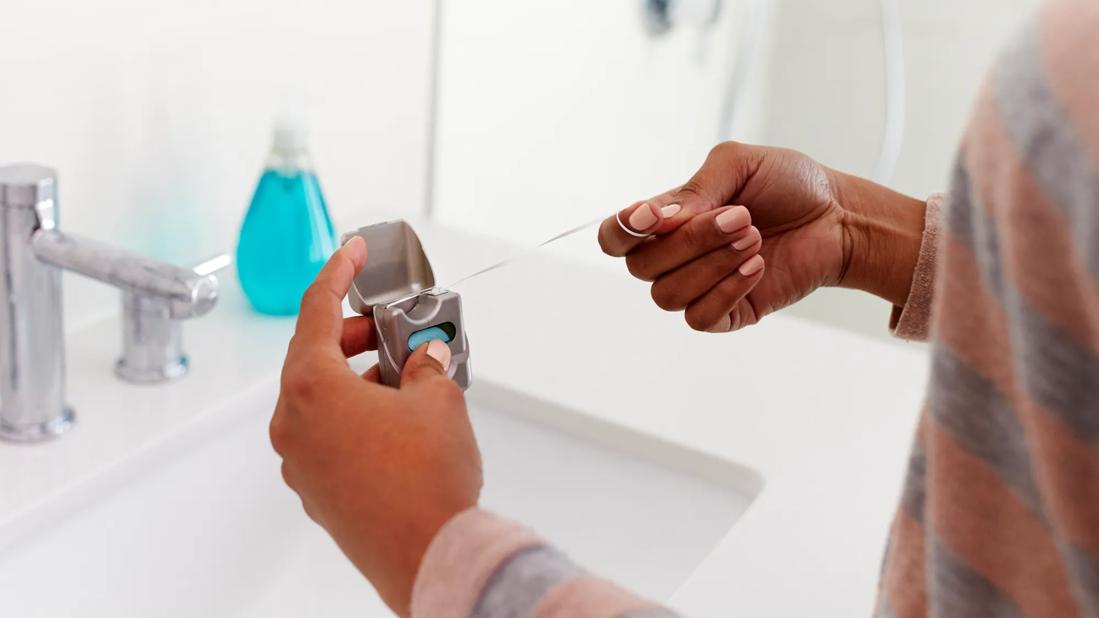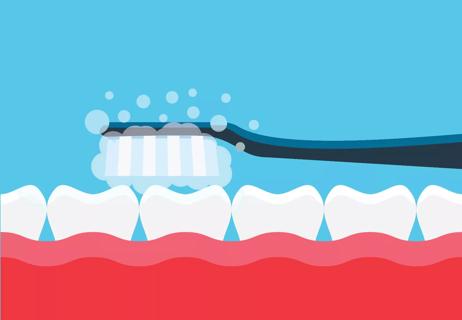Bloody gums after flossing usually signal a buildup of plaque, tartar and bacteria

Nobody likes the sight of blood — especially when it’s their own. So, if you finish flossing your teeth and see pink in the sink after rinsing your mouth … well, it’s understandable to have a few concerns.
Advertisement
Cleveland Clinic is a non-profit academic medical center. Advertising on our site helps support our mission. We do not endorse non-Cleveland Clinic products or services. Policy
So, let’s get to the point: It’s not normal for healthy gums to routinely bleed during flossing.
That’s not to say bleeding gums may happen from time to time. But if every up-and-down glide of floss conjures up a horror flick scene, there’s probably a deeper issue deserving attention.
We asked periodontist Sasha Ross, DMD, and dentist Anne Clemons, DMD, to explain what might be happening if you experience bleeding gums while flossing.
How often do you floss? If that question makes you uncomfortably squirm in the dentist chair, that’s probably the reason why you might sometimes experience bleeding gums.
Not flossing daily is typically the main cause of bleeding gums, emphasizes Dr. Clemons. That’s because your gum health suffers the consequences if you don’t follow a consistent oral hygiene routine.
Bacteria, tartar and plaque begin to build up along your gumline without consistent flossing. That can lead to gingivitis and irritated, swollen gums that easily bleed during flossing or brushing.
“It can happen pretty quickly, too, if you’re not staying on top of things,” she adds.
Gingivitis that goes unchecked can blossom into periodontal (gum) disease, which brings a whole new level of oral health and overall health concerns.
Advertisement
While gingivitis is the most likely cause of bleeding while flossing, it’s not the only possible explanation. Other causes could include:
Incorrect flossing technique may cause bleeding gums. How do you floss correctly? Here’s some advice from Dr. Ross.
Start off with about 24 inches of floss. Wrap the piece of floss around both your middle fingers so you have about 2 inches left to floss with. Use your thumbs and index fingers to keep the floss tight.
Place the floss between two teeth, and in a gentle up-and-down motion, move the floss along the curve of each tooth. Be careful not to go too far down into your gums.
Move on to the next set of teeth, using a clean section of floss as you go.
Brushing your teeth is a very good thing when it comes to keeping your gums healthy. In fact, you should do it twice a day (morning and night) for two minutes each time, recommends Dr. Clemons.
But the way you brush and the equipment you use can lead to bloody gums.
For starters, if you apply too much pressure when brushing you may inadvertently cause your gums to bleed. Try to aim your brush at a 45-degree angle to your gumline and use short overlapping strokes on the cheek side, the biting side and the inside of your teeth.
If you tend to be a hard brusher, maybe consider buying an electric toothbrush with a pressure sensor or intensity control to offer extra guidance.
It’s also important to select a soft-bristle toothbrush. (Hard bristles can be rough on the gums.)
Replace your toothbrush when the bristles begin to fray, too. Older toothbrushes with worn bristles may make you press down harder while brushing, causing gums to bleed.
If you have a menstrual cycle, you may notice a change in your gums. The influx of hormones like progesterone can increase blood flow, which can lead to inflamed or bleeding gums.
“The hormones can also cause changes in blood vessels and in your body’s immune response that cause bleeding gums regardless of the amount of bacteria and plaque present,” explains Dr. Ross.
This can also happen if you:
Hormonal changes that come with puberty also can increase gum sensitivity no matter your sex. It doesn’t help that children around that age also tend to be a little lax when it comes to brushing and flossing.
Unexplained bleeding from flossing may be a sign of a medical issue unrelated to your mouth. So, if you’ve been regularly flossing for years and the bleeding is new, see your dentist or a periodontist to get evaluated.
Advertisement
“Bleeding may also be a sign of a systemic condition like diabetes that is not well-controlled or has not yet been diagnosed,” explains Dr. Ross. Leukemia and hemophilia are other conditions that could affect your gums.
A deficiency in vitamin C or K can also trigger bleeding. Vitamin C helps tissue grow and repair while also strengthening bones and teeth. Vitamin K, on the other hand, helps blood clot.
The best way to manage bleeding gums is to be as diligent as possible in flossing and cleaning your teeth, particularly near your gumline.
Unfortunately, it’s estimated that fewer than 1 in 3 adults floss daily. That’s not ideal given that flossing is the most effective way for you to remove plaque and other gunk that inflames gums and makes them more likely to bleed.
If you commit to flossing and make it an everyday habit, bleeding while flossing should stop within a few weeks as your gums get healthier. All it takes is a few minutes a day of extra attention on your teeth.
“Daily flossing reduces gum inflammation and creates gum health,” reinforces Dr. Ross.
Getting professional teeth cleaning twice a year also can keep plaque and tartar from building up, too. Those visits allow your dentist to evaluate your gums' ongoing health, too. Talk to them about any concerns with bleeding gums.
Advertisement
Bottom line? You CAN make your gums less likely to bleed during flossing.
“If you floss every day, you’ll see the difference in how your gums look and feel,” affirms Dr. Clemons. “It really can be empowering to have such an effect on your health just by doing this one little habit.”
Advertisement
Learn more about our editorial process.
Advertisement

You might have a sensitive gag reflex — but gagging while brushing can also be a result of certain medical conditions

An old, worn toothbrush is a hazard to your teeth and gums and a breeding ground for germs and bacteria — replace it every three to four months at least

Done correctly, daily flossing can help keep your teeth and gums healthy

A variety of products can be effective at removing stains on teeth

Despite unfounded theories, fluoride has the power to make your teeth stronger

Studies show they do a better job than manual brushes at removing plaque and debris

This tool is an add-on to your regular brushing and flossing habits, not a replacement for them

Brushing for two minutes, twice a day is your baseline for dental health

Start having sex about 72 hours before ovulation, then at least every other day during your fertile window

Attachment theory suggests that your earliest relationships shape connections throughout your life

It isn’t a recognized mental health disorder, but research shows that problematic social media use can negatively affect your mental health, self-esteem and sleep